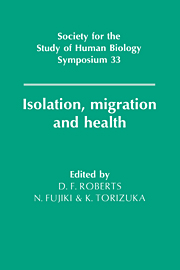Book contents
- Frontmatter
- Contents
- List of contributors
- Preface
- 1 The legacy of the IBP: Presidential Address
- 2 The distinction between primary and secondary isolates
- 3 Time trends in the break-up of isolates
- 4 Factors influencing the frequency of consanguineous marriages in Japan
- 5 Break-up of isolates
- 6 Isolates in India: their origin and characterisation
- 7 Consanguineous marriages and their genetical consequences in some Indian populations
- 8 Biomedical and immunogenetic variation in isolated populations in India
- 9 Genetic distance analyses in Israeli groups using classical markers and DNA polymorphisms in the β globin gene
- 10 Non-random distribution of Gm haplotypes in northern Siberia
- 11 Allele frequency estimation
- 12 Genetic affinities of human populations
- 13 Inherited neurological diseases in island isolates in southern Japan
- 14 Serological and virological evidence for human T-lymphotropic virus type I infection among the isolated Hagahai of Papua New Guinea
- 15 Analysis of genes associated with hypercholesterolaemia in the Japanese population
- 16 Migrant studies and their problems
- 17 Tokelau: migration and health in a small Polynesian society - a longitudinal study
- 18 Micromigrations of isolated Tuareg tribes of the Sahara Desert
- 19 Population structure in the eastern Adriatic: the influence of historical processes, migration patterns, isolation and ecological pressures, and their interaction
- 20 Diabetes and diabetic macroangiopathy in Japanese-Americans
- 21 Diabetes and westernisation in Japanese migrants
- 22 Environmental factors affecting ischemic heart disease
- Epilogue
- Index
4 - Factors influencing the frequency of consanguineous marriages in Japan
Published online by Cambridge University Press: 05 March 2012
- Frontmatter
- Contents
- List of contributors
- Preface
- 1 The legacy of the IBP: Presidential Address
- 2 The distinction between primary and secondary isolates
- 3 Time trends in the break-up of isolates
- 4 Factors influencing the frequency of consanguineous marriages in Japan
- 5 Break-up of isolates
- 6 Isolates in India: their origin and characterisation
- 7 Consanguineous marriages and their genetical consequences in some Indian populations
- 8 Biomedical and immunogenetic variation in isolated populations in India
- 9 Genetic distance analyses in Israeli groups using classical markers and DNA polymorphisms in the β globin gene
- 10 Non-random distribution of Gm haplotypes in northern Siberia
- 11 Allele frequency estimation
- 12 Genetic affinities of human populations
- 13 Inherited neurological diseases in island isolates in southern Japan
- 14 Serological and virological evidence for human T-lymphotropic virus type I infection among the isolated Hagahai of Papua New Guinea
- 15 Analysis of genes associated with hypercholesterolaemia in the Japanese population
- 16 Migrant studies and their problems
- 17 Tokelau: migration and health in a small Polynesian society - a longitudinal study
- 18 Micromigrations of isolated Tuareg tribes of the Sahara Desert
- 19 Population structure in the eastern Adriatic: the influence of historical processes, migration patterns, isolation and ecological pressures, and their interaction
- 20 Diabetes and diabetic macroangiopathy in Japanese-Americans
- 21 Diabetes and westernisation in Japanese migrants
- 22 Environmental factors affecting ischemic heart disease
- Epilogue
- Index
Summary
Introduction
In a nationwide survey, the rate of total consanguineous marriages in Japan decreased from 16% to 3% in the period of 25 years from 1947 (Imaizumi et al., 1975). This tendency continued to 1983, as shown by Imaizumi (1986a) in six sample areas representative of all Japan (Figure 4.1). According to Shinozaki (1961), the rate of consanguinity in Japan for the marriage years from 1912 to 1925 was 22.4%, it then slowly decreased to about half that level (12.3%) for the period 1941 to 1945, and after the Second World War a rapid decrease occurred. The inbreeding coefficient (F) in isolated populations in Japan decreased during the period from 1926 to 1963 (Yanase, 1966), though there remained appreciable variation. From the nationwide survey data of Imaizumi et al. (1975) the mean F value in rural areas in Japan (0.0029) was twice that in urban areas (0.0014), and out of eight districts it was highest in Kyushu (0.0034) and lowest in Hokkaido (0.0009). Similar decreases with time have occurred elsewhere, e.g. in Spain the inbreeding coefficient (F) remained constant during the period from 1900 to 1959 and has decreased consistently over the last two decades (Calderon, 1989).
The decline of the consanguinity rate is usually attributed to higher mobility of the population and therefore a wider choice of possible spouse. This paper investigates the effects of marital distance (between birthplaces), religion, socioeconomic factors, marriage form, and opportunity of meeting on the rate of consanguineous marriages in Japan, and also reports the stated reasons for consanguineous marriages: it summarises results reported elsewhere (Imaizumi, 1986a,b,c, 1987, 1988).
- Type
- Chapter
- Information
- Isolation, Migration and Health , pp. 29 - 40Publisher: Cambridge University PressPrint publication year: 1992
- 1
- Cited by



